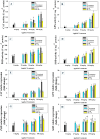Silicon (Si) foliar treatment modulates Capsicum annuum L. (green chilli) growth and stress responses under cadmium and lead stress
- PMID: 40584848
- PMCID: PMC12202647
- DOI: 10.3389/fpls.2025.1590148
Silicon (Si) foliar treatment modulates Capsicum annuum L. (green chilli) growth and stress responses under cadmium and lead stress
Abstract
Silicon (Si) plays a crucial role in improving plant resilience against abiotic stresses including heavy metals (HMs). However, little is known about its role in chilli plants during HM stresses like cadmium (Cd) and lead (Pb). The present study aimed to evaluate the role of Si in chilli plants grown under different concentrations of Cd and Pb respectively. Based on our findings, the increased levels of Cd and Pb adversely affected the physiological and biochemical traits in chilly plants. For instance, at 100 mg kg-1, Cd and Pb significantly reduced the seed germination (62.5% and 50%), vigor indices (67.2% and 56.8%), root biomass (88% and 66%), chlorophyll a (75.5% and 55.5%) and carotenoids (56.4% and 48.7%) in chilly plants. However, supplementation of Si in chilli plants aids them in recovering from Cd and Pb side effects by improving their physiological and biochemical traits. At 25 mg kg-1 soil Cd and Pb, Si significantly (p ≤ 0.05) improved the root length (17% and 24%), root biomass (23% and 27%), and carotenoids (16% and 19%) of chilli plants compared to control plants. Moreover, Si application significantly (p ≤ 0.05) reduced the oxidative stress markers; malondialdehyde (MDA), electrolyte leakage (EL), hydrogen peroxide (H2O2), and superoxide radical (O2-) in Cd and Pb stressed chilli plants as compared to non-Si treated plants. Interestingly, Si foliar application in Cd and Pb-treated chilli plants upregulates the transcript levels of POD, SOD, CAT, and GPX genes. Additionally, Si reduces the HM-induced phytotoxicity by decreasing Cd and Pb uptake in roots and shoots of chilli plants, as well as metal translocation (TF) and bioconcentration (BCF) factors. In summary, these results highlight the protective role of Si in chilli plants by mitigating the side effects of Cd and Pb stress. Hence, Si fertilizers can be used in sustainable agriculture to mitigate HM toxicity and improve crop productivity.
Keywords: heavy metals; metal uptake; resilience mechanism; silicon (Si); stress responsive gene.
Copyright © 2025 Ansari, Shahid, Danish, Ali, Almalki and Alfredan.
Conflict of interest statement
The authors declare that the research was conducted in the absence of any commercial or financial relationships that could be construed as a potential conflict of interest.
Figures









References
-
- Abd-Allah E. F., Hashem A., Alam P., Ahmad P. (2019). Silicon alleviates nickel-induced oxidative stress by regulating antioxidant defense and glyoxalase systems in mustard plants. J. Plant Growth Regul. 38, 1260–1273. doi: 10.1007/s00344-019-09931-y - DOI
-
- Adepoju A. O., Femi-Adepoju A., Jalloh A., Faeflen S. (2024). Soil pollution and management practices. EPH, 187–236. doi: 10.1016/B978-0-323-95967-4.00011-8 - DOI
LinkOut - more resources
Full Text Sources
Miscellaneous

